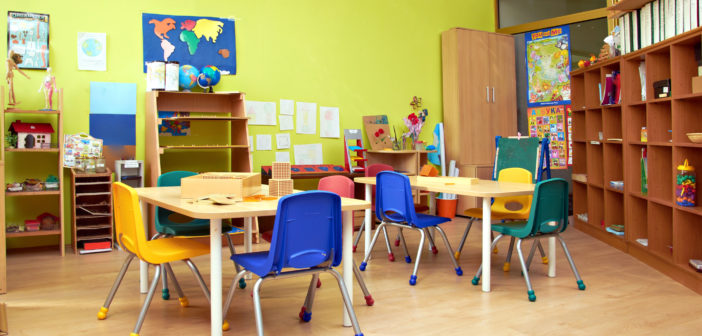Now that I’m a parent myself, teachers resemble something of a superhero to me. When I look at their color-coordinated, immaculately organized classrooms and the way they confidently corral over 20 children into listening, I’m in awe. And don’t get me started about their effective time-management, tight schedules, and ability to teach kids both academic content and important life lessons at the same time. I was curious about how I could get some of their superpowers (and share it with other NJMOMS), so I went straight to the source—I asked NJ teachers for their tips and tricks on how to navigate this school year, in and out of the classroom. Read on for their advice on making it the best year for your kids and you.
Featured image: Istock/poplasen
Make homework spaces exciting
“I spend days before school starts creating a colorful, bright, and fun classroom that students are excited to enter, which boosts productivity and learning,” says Dena Orfanitopoulos, an enrichment teacher for Kindergarten through 4th grade. Carry on this concept at home, and create a workable, yet enticing, space where kids want to spend their time after school—and hopefully end those dreaded homework battles.
Use a visual aid to help children pay attention
“To control class volume, I use a zero to three scale with tap lights, which are easily found in a pack of three,” says Orfanitopoulos. “I turn on the light to symbolize which voice level students should have—zero meaning voices off, one for a whisper, two for table talk, and three for a speaker voice. Students get a visual reminder with the light and this helps them stay on task.”
Reward good behavior
“For a whole class management system, I give the class a star on a chart if they were well behaved, followed the rules, or worked as a team,” says Orfanitopoulos. “When they reach five stars, they earn a reward.” A reward system could work for multiple children at home or individual children who are struggling with good behavior.
Establish routines
To become more organized at home as a parent, Orfanitopoulos suggests implementing routines. “Children love consistency,” she says. “Aim for a set time to do homework, and have a spot in the house dedicated to homework and school items—this will also prevent work from getting lost.”
Ask in-depth questions
During the school year, it’s important to check in with your child. “Ask your child detailed questions, and not ones they can just answer with a ‘yes’ or ‘no’,” says Orfanitopoulos. By asking for specifics, you’ll get a better idea of what’s happening learning and social-wise, and be able to follow-up with continued conversations.
Create a picture schedule
Chelsey Odgers, an art teacher for Kindergarten through 2nd grade, boasts the wonders of a picture schedule—a chart that uses images to demonstrate how a child can complete an activity or routine. “Create a visual chart with pictures for your child, so they know what they need to do to get ready for school,” says Odgers.
Use the ‘first, then, last’ method
While implementing instructions for an at-home routine, Odgers says to use a first, then, the last approach—first you will get dressed, then you will brush your teeth, last you will pack your backpack— that will break it down into basic steps that won’t overwhelm the child.
Make dreaded tasks or chores fun
If you have a younger child who is reluctant to put away their things, it’s helpful to make the experience amusing. “Make routines fun by using a timer, countdown, or song,” Odgers recommends. “For example, you can say when I play the clean-up song, you have to put everything away before the song ends.”
Get to know all your child’s teachers
“My best piece of advice for parents heading into the school year is to get to know their child’s teachers,” says Dayna Ensminger, an art teacher for Kindergarten through 5th grade. “Sometimes, parents don’t realize there are so many teachers in their children’s lives. These teachers work with the main classroom teacher for many different things, and we are all critical to shaping their child’s success and future.”
Have an open dialogue with the school staff for optimal student success
“As teachers, we want your child to discover what they love and figure out how to be an amazing human,” explains Ensminger. “When a parent gets to know us better, it easily helps us guide their child to succeed.”
Create “Quiet Critters”
When Ensminger wants her younger students to practice self-control, she creates a “class pet” by gluing googly eyes and felt feet onto pom poms. “I tell the students that these pets are Quiet Critters, who love art and only come to visit when we are working quietly,” she explains.“ It really helps the students self-regulate and control their volume because they LOVE having a little critter visit them.”
Encourage children to take responsibility for themselves
Ensminger always lets her students know that they should be taking ownership of their artwork, from creation to clean-up—a concept that can also be applied at home. “I expect my students to clean up after themselves and be responsible for their table and material organization. Before any project, we discuss proper use of materials and the expectations.”
Get everything in order the night before
“Plan the night before,” says teacher Annie Blaso, “It makes your day that much easier.” This could be anything from having your child pack up their backup to picking out their outfits before bed to make the mornings run smoother.
Use a call-and-repeat method to help kids focus
“As a certified educator and special class aide, I’ve seen a number of different ways that teachers get their class to listen effectively,” says one anonymous teacher. “A clapping pattern, song, or rhyme is a great way to get children to stop and listen. Choose something that is easy to follow, and that a child can easily repeat back.”
Read at least 20 minutes each day
“At the school district I work at, 20 minutes of reading a day is mandated and strongly advised as a part of every student’s homework curriculum to help them better successful readers,” she continues. Implementing this at home before bedtime is a good idea, even if your child’s school doesn’t require it. “Reading before bed helps calm children and promotes better sleep, too.”
Color code to keep organized
“I make sure to color code school supplies,” advises Marissa, a former elementary school occupational therapist, and mother of two toddlers. “Folders and notebooks should be the same color for each subject, which makes them easy to access.”










